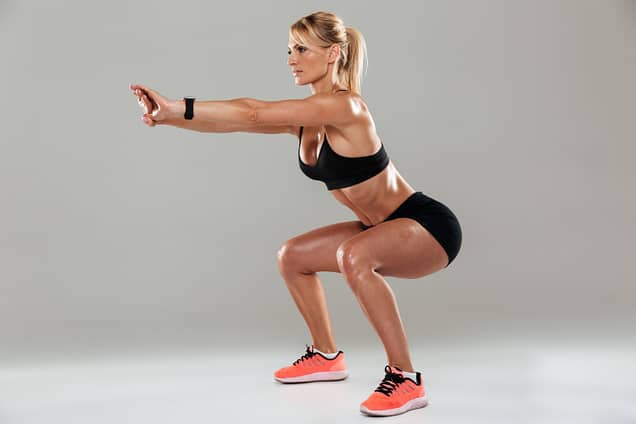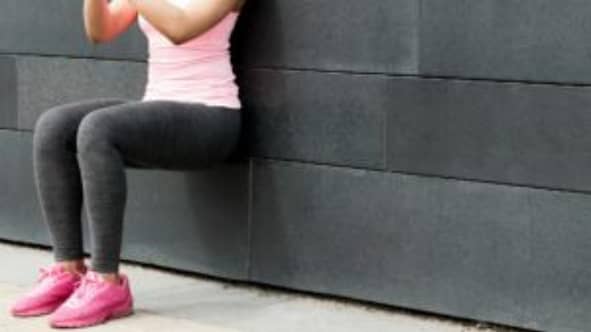Table of Contents
Toggle1. Bodyweight Squats
Starting with basic bodyweight squats can be beneficial. Ensure proper form—feet shoulder-width apart, toes slightly turned out, and knees tracking over the toes as you lower yourself into a squat. Focus on controlled movements and proper alignment.

2. Wall Squats
Leaning against a wall while performing squats can provide support and stability. Slide down the wall into a squat position, keeping your back against the wall. This reduces strain on the knees and helps maintain correct posture.

3. Box Squats
Box squats involve sitting back onto a box or bench before standing up again. This reduces the depth of the squat, minimizing stress on the knees while still engaging the muscles.
4. Partial Range of Motion Squats
Limiting the range of motion can be beneficial during rehabilitation. Performing squats with a reduced range of motion avoiding going too low can help decrease strain on the knees while still allowing muscle engagement.

5. Supported Squats
Using a chair, railing, or similar support while performing squats can assist in maintaining balance and stability, especially for individuals with limited mobility or weakness in the knees.
6. Goblet Squats
Hold a weight close to your chest while performing squats. This helps with balance and stability while engaging the core and lower body muscles.

What to Avoid:
Deep Knee Bends
During knee rehabilitation, it’s often recommended to avoid exercises that involve deep knee bends, such as full-depth squats or weighted lunges, as these can place excessive stress on the knees and may hinder the recovery process.
Always consult with a healthcare professional or a physical therapist before starting any exercise regimen, especially during knee rehabilitation. They can provide personalized guidance based on your specific condition and needs. Gradually increase the intensity and range of motion as your knees strengthen and adapt to the exercises.
Other knee rehabilitation exercises:
Isometric Squats
Isometric exercises involve holding a position without movement. Isometric squats can help strengthen muscles without putting excessive stress on the knees. Hold a squat position at a comfortable depth for a few seconds before slowly standing up.
Step-Ups
While not a traditional squat, step-ups engage similar muscle groups and aid in knee rehabilitation. Step onto a platform or bench using one leg at a time, then step back down. This exercise helps improve balance, stability, and strength in the lower body.
Resistance Band Squats
Incorporating resistance bands into squats can provide gentle resistance, aiding in muscle strengthening without causing undue stress on the knees. Loop a resistance band around your thighs or ankles while performing squats.
Eccentric Squats
Eccentric exercises involve focusing on the lowering phase of a movement. Slowly lower yourself into a squat position and then use assistance, like a chair or support, to return to a standing position. This emphasizes controlled movement and muscle engagement during the descent.
Balance and Stability Squats
Perform squats on unstable surfaces like a balance pad or a Bosu ball. This challenges the stabilizing muscles around the knee, improving balance and coordination while strengthening the lower body.
Tempo Squats
Controlling the speed of the squat can be beneficial for rehabilitation. Perform squats with a slow and controlled tempo, emphasizing the eccentric (lowering) phase to strengthen muscles and improve control.
Leg Press Machine
In some cases, the leg press machine can be used under the guidance of a physical therapist. Adjust the machine to a comfortable position that does not cause knee pain and perform controlled leg presses to strengthen the quadriceps and other leg muscles.
Remember, it’s essential to start with low resistance and gradually increase it as your knee strength improves. Listen to your body and avoid pushing through pain or discomfort. Consistency and proper form are key in knee rehabilitation exercises.
Always seek guidance from a healthcare professional or a qualified trainer to ensure that the chosen exercises are suitable for your specific condition and to receive personalized recommendations for your rehabilitation program.
External Resources:
Cleveland Clinic – Knee Exercises to Help Avoid Injury and Reduce Pain
PhysioWorks – Knee Strengthening Exercises
Harvard Health Publishing – Exercise for Stronger Knees and Hips
| Squat Type | Description | Benefits |
|---|---|---|
| Bodyweight Squats | Basic squats using your body weight. | Strengthens muscles, promotes proper form. |
| Wall Squats | Squats with back against a wall for support. | Reduces strain on knees, maintains posture. |
| Box Squats | Squatting onto a box or bench, limiting depth. | Minimizes knee strain, engages muscles effectively. |
| Partial Range of Motion | Squats with reduced depth, avoiding going too low. | Decreases knee strain while engaging muscles. |
| Supported Squats | Squats using a chair or railing for stability. | Assists in balance and support during squats. |
| Goblet Squats | Squats while holding a weight close to the chest. | Enhances balance, engages core and lower body muscles. |
| Isometric Squats | Holding a squat position without movement. | Strengthens muscles without knee movement. |
| Step-Ups | Stepping onto a platform, engaging similar muscles. | Improves balance, stability, and lower body strength. |
| Resistance Band Squats | Squats using resistance bands for added challenge. | Gentle resistance strengthens muscles without stress. |
| Eccentric Squats | Emphasizing the lowering phase of the squat. | Builds muscle control and strength during descent. |
| Balance and Stability Squats | Squats on unstable surfaces like a Bosu ball. | Challenges stabilizing muscles, improves balance. |
| Tempo Squats | Squats performed with a controlled, slow tempo. | Emphasizes controlled movement for muscle strength. |
| Leg Press Machine | Controlled leg presses on a machine (under guidance). | Targets quadriceps and leg muscles without knee strain. |
Each squat variation offers unique benefits and focuses on different aspects of knee rehabilitation. Remember to consult a healthcare professional or a physical therapist to determine which exercises are suitable for your specific condition and rehabilitation goals. Gradually progress in intensity and range of motion based on your comfort and strength level.
Wrapping up
When it comes to knee rehabilitation through squat exercises, the key is to prioritize safety, form, and gradual progression. Every individual’s journey toward knee recovery is unique, and selecting the right exercises can make a significant difference in the rehabilitation process.
Start with basic bodyweight squats or supported variations to establish proper form and build foundational strength. As your knees become stronger, gradually introduce other squat variations, always focusing on controlled movements and avoiding exercises that cause discomfort or pain.
Consulting with a healthcare professional or a physical therapist is invaluable. They can assess your specific condition, recommend appropriate exercises, and provide guidance throughout your rehabilitation journey.
Consistency and patience are essential. Slow, steady progress is more important than pushing too hard, too soon. Listen to your body, and don’t hesitate to adjust exercises or seek guidance if needed.
Remember, rehabilitation is a gradual process. With dedication, proper guidance, and the right exercises, you can strengthen your knees and regain mobility, leading to a healthier and more active lifestyle.

Hey there, it’s Mike Rrsq, the Editor-in-Chief over at Jsquat.com, and I’m absolutely obsessed with all things squat fitness! I’ve been lucky enough to get some serious recognition for my work in this field. With a solid background in the fitness and wellness industry, I’ve been there right from the get-go, helping shape this website into what it is today.
You see, I’m not just the boss around here; I’m also a passionate contributor. I love sharing my insights through my articles, and trust me, they’re not your run-of-the-mill stuff. Each piece I write is a labor of love, filled with my expertise and real-world experience in the fitness universe. So, if you’re into fitness and looking for some inspiration, you’re in the right place!
Related Posts
- The Best 3 Most Effective Squat variations for targeting the obliques.
Squats are renowned for their ability to strengthen and tone the lower body, but did…
- Best 3 most effective squat variations you need for targeting the adductor magnus.
Squat is one of the most effective exercises that you can do to target quads…
- The Top 3 Effective Squat Variations you need for better swimming performance.
Swimming is an intricate sport that demands a blend of strength, endurance, and technique. While…
- The best 5 most effective squat variations you need for better basketball performance
Basketball demands a unique blend of strength, agility, and explosive power. Choosing the right squat…
- The best 3 most effective squat variations you need for better soccer performance.
Squats are a foundational exercise for athletes across various sports, and for soccer players, they…
- Are Squats Without Weight Effective? (Explained)
Are you wondering if squats without weight are worth your time? Learn the benefits and…
- The top 3 effective squat Variations 19-year-old males need to build explosive strength
Squats are foundational exercises for enhancing lower body strength and power. For a 19-year-old male…
- The Top 3 Effective Squat Variations you need for better volleyball performance
Volleyball demands agility, power, and endurance. As an athlete, fine-tuning your performance can be the…

